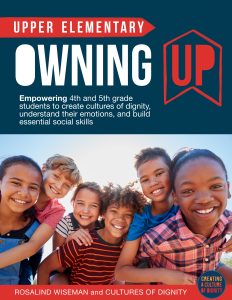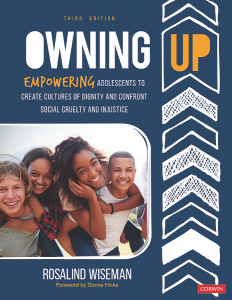These past two school years have been like no other. Before you engage in deeper concepts, you may need to spend more time setting up guidelines, getting to know each other, and having fun. These Back to School Social Emotional Wellness Lessons help set up your classroom, acknowledge the past, and build relationships. Establishing these relationships at the beginning of the school year is critical to your success in building the culture and climate you want in your classroom and school.
2021 Back to School Lessons: Setting the Framework for Social Emotional Wellness
Back to School Social Emotional Wellness Lessons
How to create connection in the classroom after a year of constant change.
These activities are designed to compliment The Owning Up Curriculum and can also be used as stand alone lessons to start the school year.
Back to School Social Emotional Wellness Lessons
Additional Activities and Tweaks
Here are a few other back to school social emotional wellness lessons and activities you can add to your classroom to build a positive climate and culture for you and your students. Offering these activities and participating with your students is a great way to create some fun and connect with students in short moments without needing time for a full lesson. These activities can be done in advisory and Owning Up time or in any class you teach. You can toss the beach ball for the first or last few minutes of class to lighten things up and get to know each other in a silly way. The gratitude activity can be altered in many ways and can be an opportunity to model positivity and gratitude.
Beach Ball Activity
This is a great introductory activity that can be used in any class. Bring a beach ball (or multiple) to class and ask your students to come up with questions to write on the beach ball. If they need some prompts you can start with a few silly questions like, what chore do you hate to do the most? what is your favorite color of shoe? Letting them create the questions is a great way to get them involved and invested in the activity.
When the beach ball has plenty of questions, toss it to someone to get started. Have them toss the beach ball to someone new each time and whatever question their left thumb is closest to when they catch it is the question they answer. Keep going until each student answers at least one question.
This game could also be used to review your subject matter. You could write questions related to what is coming up on an assessment to help the kids review and learn from each other on how they understand a concept.
This is in Owning Up – Session 1: Let’s Get To Know Each Other Activity
Gratitude Activities
Students can perceive forced gratitude as immature or superficial. Please be mindful of your group, their maturity, and their willingness to buy into things like this. If you are comfortable with it, and it feels natural, your students will follow. You may want to acknowledge that these types of activities can be cheesy but they are secretly fun and create a positive environment. There are many ways to incorporate gratitude into the classroom; below are a few examples.
Reasons To Be Happy Activity
Start a list of “Reasons To Be Happy” on the board each day; have students add to the list on the way in or out the door or whenever it is appropriate in your class. This can create opportunities for conversation with different students about what they add to the list and why.
Gratitude Jar Activity
Give your class, including yourself, slips of paper at the beginning of the year and have everyone write down what they are grateful for, they can be anonymous or add their name. Pull out one or more slips each day to read aloud. If time allows, you can ask the person that wrote it to explain their gratitude more in depth or just post the slips of paper in a designated place in your classroom.
As the year goes on, encourage your class to add to the jar. There will always be things to be grateful for that your class doesn’t think of in the first sitting.


